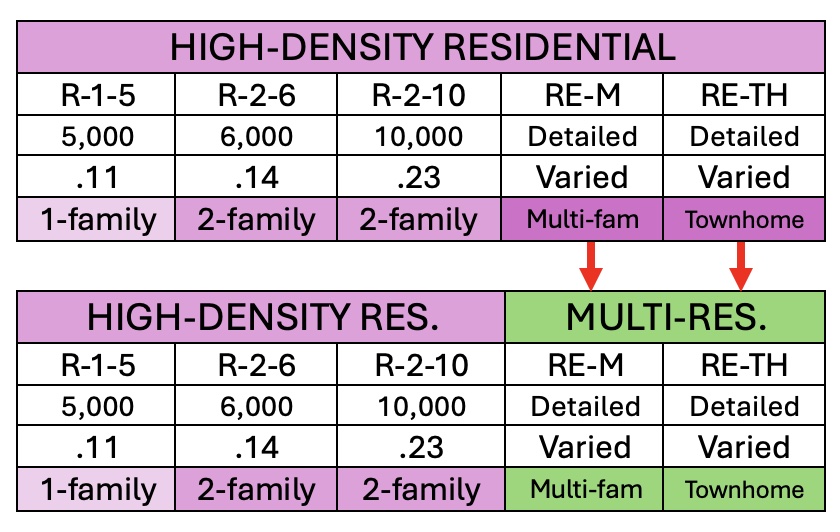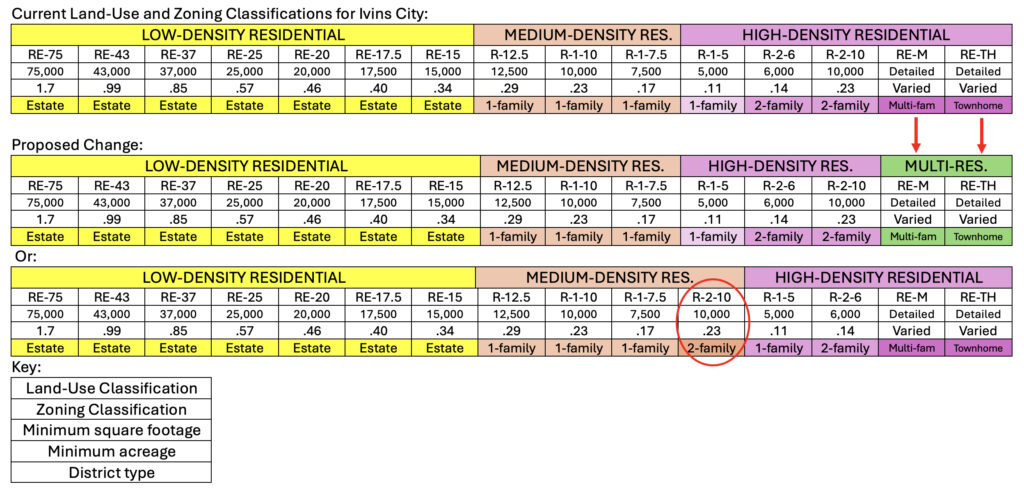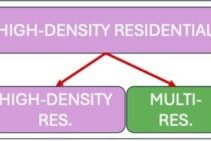How to improve Ivins’ Zoning and Land Use
Most people want to see young families move into Ivins, but it is often too expensive for them to do so. As a result, Ivins is rapidly becoming a place where only retirees can live.
The high cost of housing here is partly due to the high cost of land. There isn’t much that we can do to reduce that, and restricting growth in a heavy-handed way will only make land more expensive. Is there a way that we can improve housing availability for young families that remains true to Ivins’ spirit? I think that there is. The problem has to do with the relationship between the Land Use classifications and the Zoning classifications.
Our Land Use Plan has classifications that each contain a number of zoning options, and as long as a developer’s request is for any of the zoning options included within that classification, the city must approve the request, requiring any future application for much more dense housing that may come up at that location to also be permitted. In order for a parcel to be zoned for, say, two-family homes, the Land Use Plan would need to be revised from Medium-Density Residential (MDR) to High-Density Residential (HDR). But this would also permit extremely dense multi-unit structures such as townhomes, and nobody in Ivins wants this, except perhaps in very limited locations. So, the city’s “hands are tied” and they deny the request, forcing the developer to work around it in some odd way, or design the parcel with fewer, more expensive, homes.
One recent example involved modest two-family homes proposed on quarter-acre lots for a few parcels between Kayenta and Old Highway 91. The proposal called for maintaining the Kayenta style, which includes low stucco houses, built partly into the ground to protect the views of Red Mountain, and conservation of the desert landscape. Sounds like a no-brainer, right? But it’s not that simple, due to the fact that this type of housing is considered HDR, the same as townhomes. So the application was not approved, and the developer went back to finding a work-around.
But the solution is indeed simple. A previous City Council created this system, which may have made sense when the city was small. A new City Council can change it in a way that makes sense now. Either move the zoning appropriate for two-family homes on quarter-acre lots from High to Medium Density Residential land use, or create a new Land-Use classification for more than two units per building, such as townhomes. Then, modestly dense one- or two-family homes on reasonable lots could be approved without opening the door to townhomes or condos. This graphic, showing details of the HDR Land Use classification, illustrates this concept.

(The table includes the Land Use Classification, the Zoning classification, the minimum lot size in square feet and in acres, and the district name.)
Of course, the devil is in the details. Any such reclassification will need to be evaluated carefully, with citizen input, developer input, and surveys of other cities and their zoning-land use relationship.
This position is not a popular one. Although many people insist that they would like new homes to be affordable by young families, almost any concrete proposal to achieve this goal is met with derision. In fact, my support of two-family homes on quarter-acre lots has already cost me many votes, being labeled as a supporter of “multi-housing” … Oh well, nobody said it would be easy.
———– Additional notes for the truly interested ———–
The three (3) Land Use classifications used in Ivins are broad, encompassing fifteen (15) residential Zoning classifications, and there are additional classifications for commercial, resort, and agricultural use. These Land Use classifications are intended for coarse-level planning of future development, while the Zoning classifications are intended to proscribe the details of the structures allowed at the site.
The simplest solution to the two-family units on quarter-acre lots, from the example of two-family homes, was shown above. It simply breaks out the extremely dense housing types (more than two units per structure), and creates a new Land Use classification for them, called Multi-Housing for this example.
An equally promising solution would be to move the Zoning classification for 2-family homes on quarter-acre lots out of the HDR and into the MDR Land Use classification. This is shown in the third segment of a graphic including all the residential classifications; I hope you can view it, but it probably requires a large screen:

There are many other similar ways to solve this problem, and each will have its currently unknown consequences for unseen problems. It is the job of your elected officeholders to examine these possible solutions and select the best one for Ivins.
Summary:
All 15 of the zoning classifications were created by a City Council some years in the past, perhaps generations ago. They may well have made sense then. But their time has come and gone. A new City Council must address these issues head on, and not simply say that their “hands are tied” or only tinker around by modifying maps without changing the underlying structure of zoning and land use planning.






